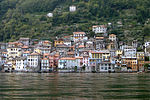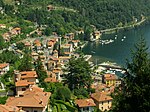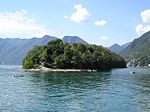Nesso
Cities and towns in LombardyMunicipalities of the Province of ComoPages with Lombard IPA

Nesso (Comasco: Ness [ˈnɛs]) is a comune (municipality) in the Province of Como in the Italian region Lombardy, located about 50 kilometres (31 mi) north of Milan and about 13 kilometres (8 mi) northeast of Como. As of 31 December 2004, it had a population of 1,294 and an area of 15.0 km². Its toponym is Celtic and means "mooring". Nesso borders the following municipalities: Argegno, Brienno, Caglio, Faggeto Lario, Laglio, Lezzeno, Pognana Lario, Sormano, Veleso, Zelbio.
Excerpt from the Wikipedia article Nesso (License: CC BY-SA 3.0, Authors, Images).Nesso
Sentiero per Alpe Colmenacco,
Geographical coordinates (GPS) Address Nearby Places Show on map
Geographical coordinates (GPS)
| Latitude | Longitude |
|---|---|
| N 45.916666666667 ° | E 9.1666666666667 ° |
Address
Sentiero per Alpe Colmenacco
Sentiero per Alpe Colmenacco
22020
Lombardy, Italy
Open on Google Maps









